#Cretaceous ammonite fossil
Explore tagged Tumblr posts
Photo

SALFIELDIELLA GUETTARDI Fossil Ammonite – Aptian – Cretaceous – Vaucluse, France
This listing features a beautifully preserved fossil ammonite of the rare species Salfieldiella guettardi, originating from the Aptian Stage of the Cretaceous Period. This specimen was discovered in Vaucluse, southeastern France, a renowned region for fossil preservation in marine sedimentary rocks.
Fossil Type & Species:
Type: Fossilised Ammonite
Species: Salfieldiella guettardi
Authority: First formally described in scientific literature for its distinct ribbing and shell morphology
Geological Context:
Era: Mesozoic
Period: Cretaceous
Stage: Aptian (~125–113 million years ago)
Locality: Vaucluse, Provence-Alpes-Côte d'Azur, France
Formation: Marine deposits of the Lower Cretaceous
Depositional Environment: Shallow marine shelf – nutrient-rich carbonate environments, supporting diverse ammonite fauna
Morphological Features:
Strongly ribbed involute shell with slightly compressed whorls
Ornamented with regular radiating ribs that curve forward on the flanks
Mid-sized for Aptian ammonites, suitable for display or academic reference
Scientific Notes:
Belongs to a family of fast-swimming nektonic ammonoids that lived in open marine settings
Commonly used in biostratigraphy to correlate Aptian strata across Europe
Fossils of Salfieldiella guettardi help refine our understanding of mid-Cretaceous marine evolution and paleoecology
Taxonomy:
Order: Ammonitida
Superfamily: Desmoceratoidea
Family: Unknown / debated due to limited preserved detail (commonly placed near Desmoceratidae in field references)
Authenticity & Display:
All of our fossils are 100% Genuine Specimens and come with a Certificate of Authenticity. The fossil you see in the photograph is the actual specimen you will receive.
Please refer to the image for full sizing details – scale cube = 1cm.
This is a rare opportunity to own a well-preserved Cretaceous ammonite with clear features, ideal for collectors, educators, and anyone fascinated by the rich marine life of Earth’s deep past.
#Salfiediella guettardi ammonite#fossil ammonite France#Cretaceous ammonite fossil#Aptian stage fossil#Vaucluse fossil specimen#genuine ammonite fossil#Salfieldiella ammonite for sale#certified ammonite fossil#French fossil ammonite#Aptian Salfieldiella fossil
0 notes
Text



7.3" Cretaceous Heteromorph Ammonite (Didymoceras) - South Dakota
#fav#cretaceous#heteromorph#heteromorph ammonite#ammonite#didymoceras#ammonoid#fossil#fossils#prehistoric#shell fossil#png#transparent#paleontology#paleoblr#paleo
87 notes
·
View notes
Text



Large Iridescent Ammonite Placenticeras costatum Late Cretaceous (approx. 71 million years ago) Bearpaw Formation, Alberta, Canada
#Large Iridescent Ammonite#Placenticeras costatum#Late Cretaceous#Bearpaw Formation#alberta canada#paleontologist#ancient artifacts#archeology#archeolgst#history#history news#fossils#art history
124 notes
·
View notes
Text










A couple of days of prospecting the Bearpaw Shale produced some little goodies like ammonites (incl. heteromorph ammonites), baculites, pearlescent clams, and mosasaur material.
#bearpaw shale#click for better quality#invertebrates#fossils#ammonite#baculite#mosasaur#marine reptile#Cretaceous#Badlands Dinosaur Museum#paleontology#paleoblr#palaeontology#palaeoblr#fieldwork 2024
100 notes
·
View notes
Text
MONDAY'S MOLLUSC: Parapuzosia
This is Parapuzosia seppenradensis, the largest known species of ammonite in the world.
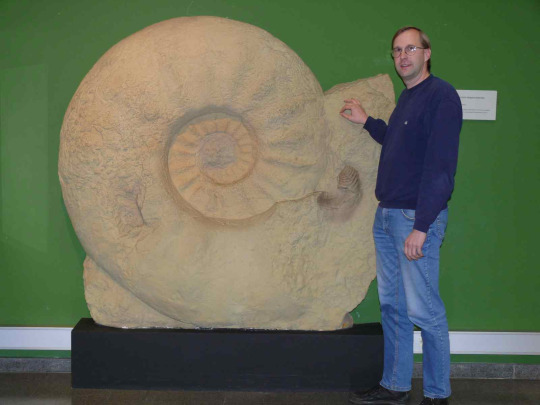
They are 1.8 m or 5.9 ft across and that that one wasn't even complete! The living chamber was missing a chunk so it's even bigger!
It lived during the Campanian Epoch of the Late Cretaceous Period in what is now Europe and North America where the Western Interior Seaway was located.
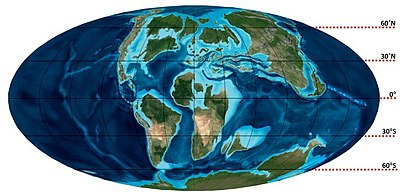
They were pelagic predators, probably feeding on fish,

squid,
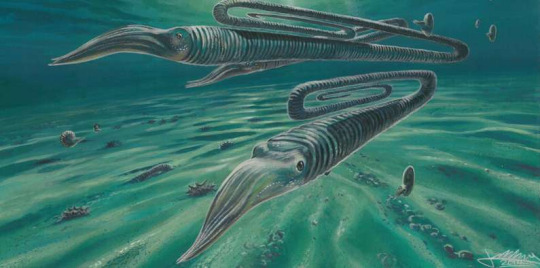
other ammonites,
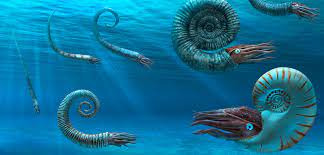
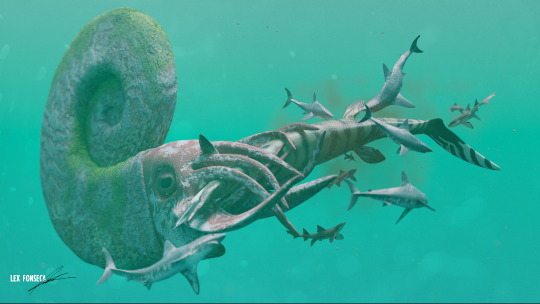
and even marine reptiles if they could catch them
all while evading adult mosasaurs who definitely had them on the menu.
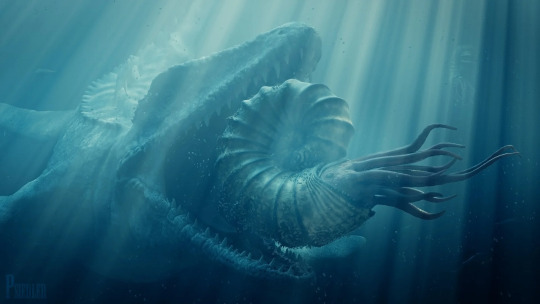
224 notes
·
View notes
Text

An ammonite fossil of a Prolyelliceras prorsocurvatum from the Machay Group in Oroya, Peru. Prolyelliceras peruvianum is likely synonymous with this Cretaceous species.
#ammonite#cephalopod#fossils#paleontology#palaeontology#paleo#palaeo#prolyelliceras#prolyelliceratidae#cretaceous#mesozoic#prehistoric#science#paleoblr#fossil friday#fossilfriday#プロリエリセラス#プロリエリセラス科#アンモナイト#化石#古生物学
27 notes
·
View notes
Text
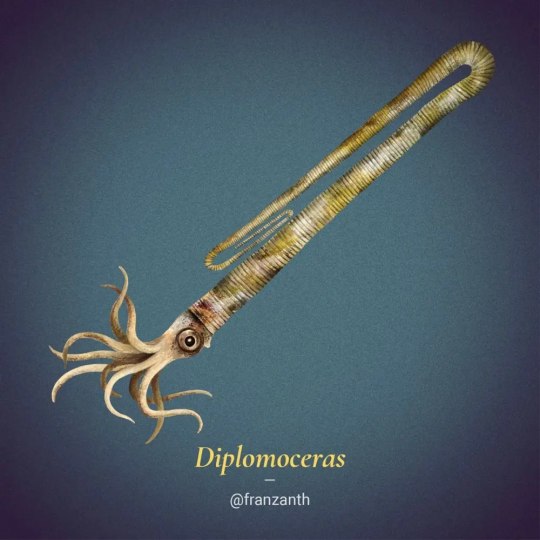
Diplomoceras
Diplomoceras — рід амонітів, що входить до родини Diplomoceratidae. Скам’янілості видів цього роду були знайдені в пізньокрейдових відкладеннях (віковий діапазон: кампан-маастрихт). Дослідження диплоцератів свідчать про те, що представники цього роду могли досягати тривалості життя понад 200 років.
Повний текст на сайті "Вимерлий світ":
https://extinctworld.in.ua/diplomoceras/
#diplomoceras#ammonite#ammonoidea#cretaceous#prehistoric planet#apple#david attenborough#bbc#hans zimmer#late cretaceous#article#maastricht#paleoart#paleontology#prehistoric#extinct#fossils#ua#ukraine#ukrainian#україна#мова#арт#український tumblr#sciart#digital art#палеоарт#тварини
2 notes
·
View notes
Text

Welcome to Gondwana Fossils !
Fossils are fascinating and valuable objects that bear witness to the rich history of life on Earth. On our website, we offer a wide selection of exceptional specimens that will delight collectors, science enthusiasts and interior decoration enthusiasts.
We offer top quality fossils, carefully selected from trusted sources and experts to ensure the authenticity and provenance of each specimen. Our collection includes ammonites, trilobites, dinosaurs and reptiles, as well as many other impressive fossils and minerals. In addition to being beautiful decorative pieces, our fossils provide scientific and educational value. They help to better understand the history of life on Earth, to generate enthusiasm for the natural sciences.
We are committed to complying with applicable regulations and to working responsibly with our suppliers. Our marketplace is a reliable and safe source to acquire top quality pieces for your collection, decoration or teaching.
In short, if you are looking to add unique and exceptional pieces to your fossil collection or if you are looking for an original piece of interior decoration, our fossil webshop is the ideal place for you. We offer you an exceptional buying experience with top quality specimens, state of the art packing and shipping, scientific expertise and assurance of the authenticity of each fossil.
#fossils#palaeontology#palaeozoic#trilobite#ammonite#cretaceous#triassic#jurassic series#jurassic period#dinosaur#prehistoric#collectibles#rocks#minerals#crystals
1 note
·
View note
Text
Stunning rare Pyritized Ammonite Fossils from the lower Cretaceous period ~ 120 mil years old.✨ Found in Volga river, Ulyanovsk region, Russia
Credit: Pacific Minerals
302 notes
·
View notes
Text
The finished fossil timescale vase! Seven periods represented by seven fossils in the seven colors of the rainbow. Closeups and fossil names below
Red: Trilobites, ammonites, and pikaia among other things for the Cambrian. Orange: Tiktaalik filling in as the Devonian representative, had to include the iconic transition fossil :] Yellow: Thrinaxodon and Broomistega in the Triassic cuddle. Green: my favorite pterosaur, Ramphorynchus, representing the Jurassic. Blue: my first favorite dinosaur, Spinosaurus, for the Cretaceous. Indigo: my favorite animal, a coelacanth, sort of wedged in for the Late Cretaceous since I couldn't come up with a better Cenozoic fossil in time. Violet: Sahelanthropus Tchadensis, an early hominid (I'm not 100% on if it's still regarded as our earliest known ancestor, cool regardless!!)



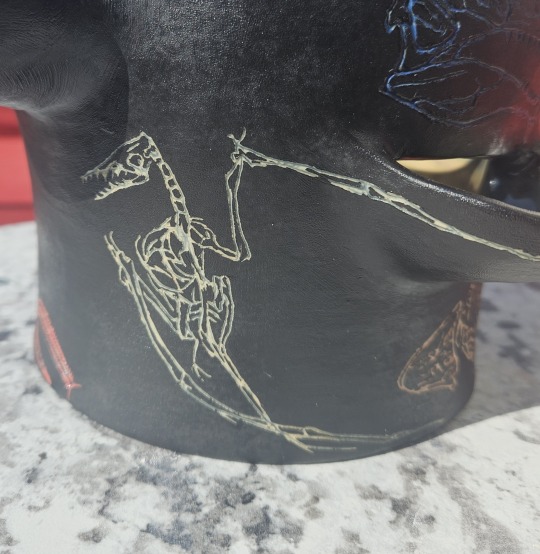
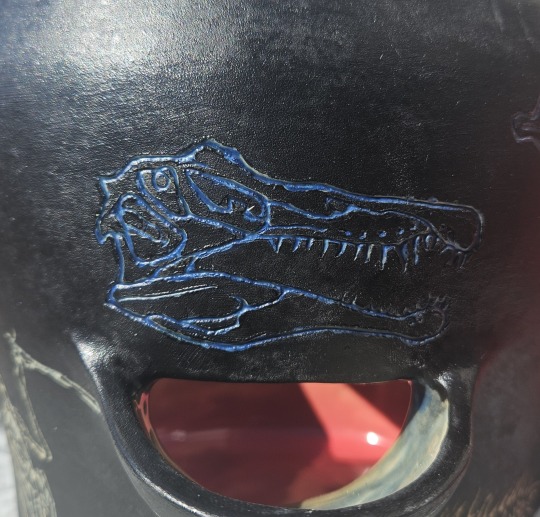


#i dunno how to fix the video getting so microwaved so uh. sorry it looks like that#i was so disgusted with this thing when i first got it back from the kiln it was baaad#cause the glazes decided to humble me for some godfosaken reason and didnt fill in half of the engravings#went and did some color matching magic with acrylics and whabam! pretty proud of it#i want to put plants in it so badly but knew i HAD to do at least one photoshoot with it nice and pristine#paleo art#paleontology#paleoblr#dinosaur#dinosaur art#trilobite#tiktaalik#thrinaxodon#broomistega#ramphorynchus#spinosaurus#coelacanth#sahelanthropus tchadensis#hominid#ceramics#pottery#carving#wasps-pots#waspsart
208 notes
·
View notes
Text

Didymoceras nebrascense - an unusual ammonite from the Late Cretaceous, ~70 million years ago, found in the seas of North America. It was one of heteromorph ammonites, known for their odd shells that formed a variety of strange and complex shapes. The spiral shell of Didymoceras, like other heteromorphs, impacted its locomotion, causing it to drift slowly with ocean currents. During that it likely used its tentacles to catch small prey, while the unusual shell shape might have helped against predators.
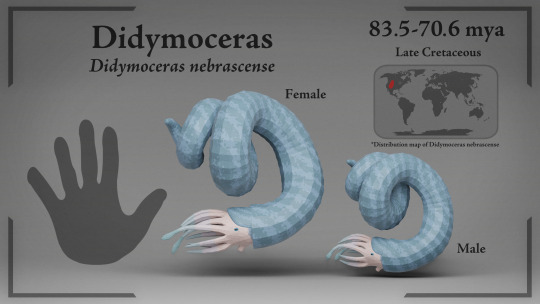
Fossil evidence suggests sexual dimorphism, with females larger than males. This size difference was likely linked to reproductive roles, as females needed more space to store eggs and additional protection, a trait common in other ammonites.

224 notes
·
View notes
Photo

Rare Mariella cenomanensis Heteromorph Ammonite Fossil – Cenomanian, Cretaceous – Seine-Maritime, France – Authentic Fossil with Certificate – Alice Purnell Collection
This listing offers a Rare Mariella cenomanensis Heteromorph Ammonite Fossil from the Cenomanian Stage of the Upper Cretaceous Period, dated to approximately 100.5 to 93.9 million years ago. It was discovered in Seine-Maritime, France, and forms part of the esteemed Alice Purnell Collection.
Mariella cenomanensis is a fascinating heteromorph ammonite, characterised by its loosely coiled, turreted shell structure. Unlike typical planispiral ammonites, heteromorphs like Mariella evolved irregular shell shapes that likely influenced buoyancy and locomotion. This unique morphology makes Mariella species highly collectible and geologically important.
The Cenomanian Stage represents the earliest part of the Late Cretaceous and is known for its rich marine fossil assemblages. During this time, France was covered by shallow epicontinental seas, offering ideal conditions for ammonite preservation. Fossils from this stage reflect the biodiversity and evolutionary complexity of Cretaceous marine ecosystems.
This specimen of Mariella cenomanensis beautifully preserves the diagnostic ribbing and elongated coiling typical of the species. It is an excellent addition for collectors of ammonites, heteromorphs, or rare European fossils.
Item Details:
Species: Mariella cenomanensis
Type: Heteromorph Ammonite Fossil
Age: Cenomanian, Upper Cretaceous (approx. 100.5–93.9 million years ago)
Location: Seine-Maritime, France
Formation: Cretaceous Marine Deposits
Source: Alice Purnell Collection
Certificate of Authenticity: Included
Scale Reference: Scale rule square/cube = 1cm. Please refer to photographs for full sizing.
ACTUAL AS SEEN: This is the exact specimen you will receive. Each fossil is hand selected and professionally photographed. Sizing is as accurate as possible, but may vary slightly due to the natural shape. Colours can differ based on lighting and screen settings. Fossils may be propped for photo display purposes.
Once sold, a new specimen will be listed with updated photos and information. We recommend saving a screenshot of your purchased listing for future reference. All specimens are recorded in our photographic archive.
Secure a rare heteromorph ammonite fossil from the Cretaceous seas of France – a scientifically significant and visually striking piece of natural history.
#Mariella cenomanensis fossil#rare heteromorph ammonite#Cenomanian ammonite France#Cretaceous ammonite fossil#Seine-Maritime fossil specimen#authentic ammonite fossil France#ammonite with certificate#Alice Purnell fossil collection#Mariella fossil France#fossil ammonite Cretaceous period
0 notes
Text
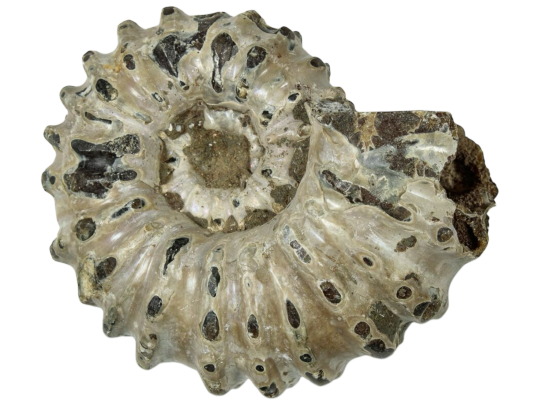
2.1" Bumpy Ammonite (Douvilleiceras) Fossil - Madagascar
#cretaceous#ammonite#bumpy ammonite#fossil shell#douvilleiceras#madagascar#png#transparent#paleontology#prehistoric#paleoblr
49 notes
·
View notes
Text



Iridescent Ammonite on Matrix Placenticeras costatum Late Cretaceous (approx. 71 million years ago) Bearpaw Formation, Alberta, Canada
#Iridescent Ammonite on Matrix#Placenticeras costatum#Late Cretaceous#Bearpaw Formation#alberta canada#fossils#paleontologist#geologists#ancient artifacts#archeology#archeolgst#history#history news
90 notes
·
View notes
Note
As adorable as being a big soft cow is, I noticed you mentioned fossils and ecology in your pin.
I think that's awesome what sort of fossils do you focus on? Ik there's a few Permian sites in Texas, closer to Mexico I believe there's some cretacous deposits. Lots of eras represented depending on where you look.
i focus on the mesozoic/late cretaceous !!! my true passion, however, lies in the biogeography and evolution of araucarian conifers 🥺🥺 i saw a monkey puzzle tree for the first time in oregon earlier this year and lost my shit for like an hour
but there’s a lot of cretaceous rock in texas!! a lot in the hill country, too :)) i grew up finding ammonites, bivalves, and gastropods !! and during summer tubing trips i always come back with a few bivalve steinkerns haha
i’m an invertebrate paleontology person tbh. i get a lot of asks about the vertebrate side of things and i honestly just don’t care for dinosaurs at all 🫣 if anything, i prefer pliocene/pleistocene mammals haha. you can find so much in TX!!
there’s a mammoth kill site a few miles from me and every time i cross that part of the highway, i say hello and goodbye to the mammoth :3
93 notes
·
View notes
Text
MONDAY'S MOLLUSC: Didymoceras
P. Diddy and Didymo bought to drop some notes!

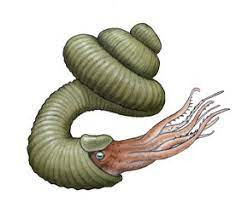
Okay, probably not and even if they did, I wouldn't know cuz I don't listen to rap but that's neither here nor there. Didymoceras is an odd looking sucker. It's like a cross between a marine snail, a doctor's signatures and a piece of coprolite.
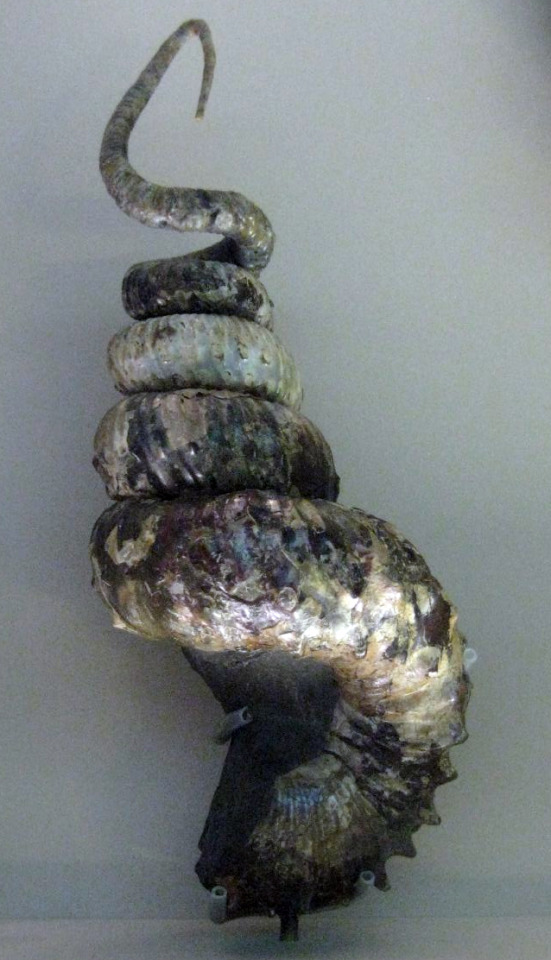
In reality, it's another hetermorphic ammonite. Like the other diva, the baculite, Didymoceras lived during Late Cretaceous. Unlike the baculite, it lived only during the Campanian Stage. There are twenty-one species of Didy and like famous rapper they all pretty much look the same (except in the case of rappers they all sound the same).
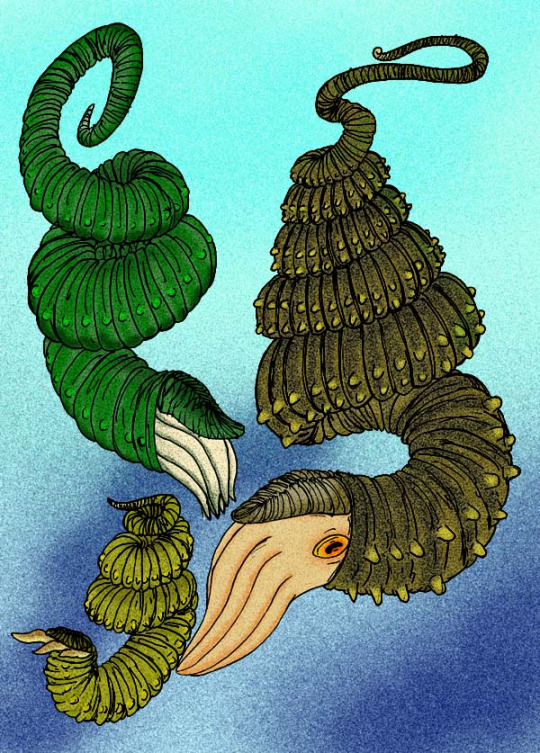
They have three growth stages: straight, curled and u-shaped. They also show sexual dimorphism (remember that?) with male specimens averaging 180 mm in height and female specimens averaging 270mm in height.
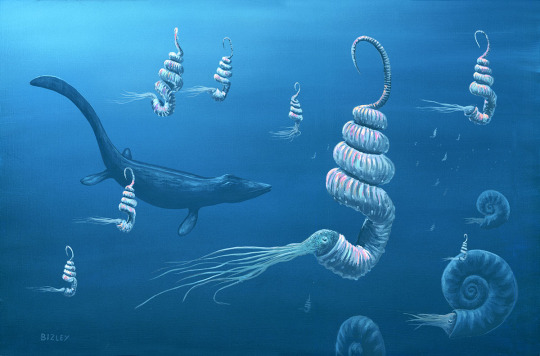
62 notes
·
View notes